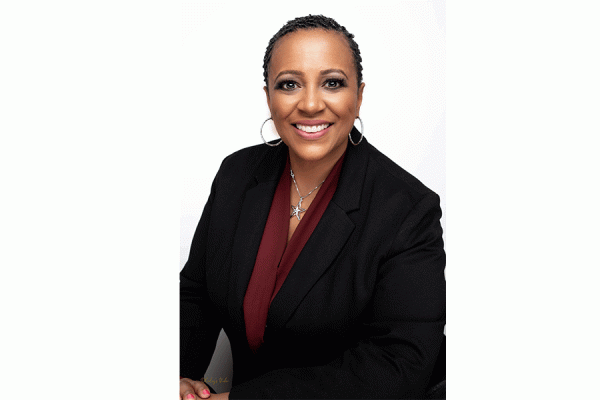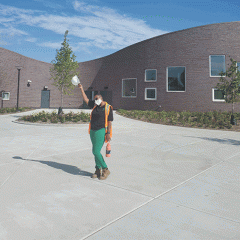Angela Brooks was drawn to the University of New Orleans graduate program in urban planning because she saw New Orleans as the perfect place to study historic preservation. However, it was one of the city’s more modern structures that propelled Brooks to a career in community development and housing.
While enrolled at UNO, Brooks worked as a probation and parole officer. One day she had to drive the young daughter of one of her client’s home. When they arrived at the apartment complex, Brooks was floored by the dilapidated buildings.
“I thought it was abandoned. I didn’t know people still lived there,” Brooks said, referring to the Iberville Public Housing Development circa 1996. “That’s what really sparked my interest in housing, because I could not believe that we had government-supported housing that looked like that.”
Brooks, who earned a master's degree in urban planning from UNO, is about four-months into a two-year term as president of the American Planning Association. The 41,000-member organization has a commitment to advancing better and more just communities through good planning and is the largest planning organization in the world, Brooks said.
As president, Brooks leads the 16-member APA Board of Directors in governing the association, setting strategic goals and elevating the importance of planning across the U.S. She is the first Black woman elected president of the American Planning Association.
“A lot of my talking points as APA president are, ‘You have to implement things on the scale that makes sense for you community,’” Brooks said. “There is no one size fits all. There are some generic strategies that probably make sense for everybody; you just have to figure out the scale for your community.”
Brooks said she would like to use her two-year tenure to help create an environment that’s “welcoming to anybody who wants to be here.” She noted that planners of color continue to make up a small part of the APA membership, as do younger planners, Brooks said.
“If I can take the next two years to elevate the voice of young emerging planners, either students or young professionals, for me that would be a great accomplishment,” Brooks said.
The APA presidency is a volunteer position that Brooks handles along with her other day job.
She’s director of the Illinois office of the Corporation for Supportive Housing, a nonprofit that offers a plethora of services aimed at developing affordable housing solutions and helping people navigate barriers to get housing.
“Anything that helps in homelessness is something we probably work on,” said Brooks, who is a certified planner.
“I’m a ‘houser.’ I house people,” said Brooks.
The versatile nature of the planning profession is part of the attraction for Brooks, who has also worked as a real estate developer.
“It’s an interdisciplinary field that really thinks about how the built environment grows and develops … and how you plan for it,” Brooks said. “Literally within the field of planning, there’s interdisciplinary types of things that you can do; it could be transportation, it could be housing, it could be core land zoning use.”
Three primary target goals for Brooks as APA president revolve around housing, climate impact and community resilience.
“How do planners help communities become safer and more resilient for future impacts? We have areas throughout the country that are being impacted by climate,” Brooks said. “We have whole states that are like, ‘Where are we going to get water in 10 years?’ How do we start thinking about that proactively?”
The shortage in affordable housing, which has reached crisis levels in many communities, is another major concern, Brooks said. As she travels to national and international planning conferences, housing is part of the discussions.
“I’ve noticed that a lot of their sessions are on housing, also. It’s just a reminder that we talk about the housing crisis in the U.S., but everybody’s dealing with how are we going to house people.”
The APA has a partnership campaign with the National League of Cities called the Housing Supply Accelerator that has brought local governments, community planners, builders, financial institutions, housing policy associations and state and federal partners together to develop, align and advance solutions for housing supply challenges at the local level.
“It’s really going to identify what are the barriers to increasing the housing supply throughout the country,” Brooks said. “What makes me excited, we have elected officials with us. As planners we can have all these great theories, we can write these great plans, but elected officials have to actually pass it and legislate it.”
Brooks was born and raised in Seattle, Washington, but is a daughter of Southern parents. Her father was born in Monroe, Louisiana and her mother is from North Carolina. She spent summers in both places and earned her undergraduate degree in planning from Jackson State University in Mississippi.
“I describe myself as Seattle-born, Southern-raised, Midwest living,” Brooks, who lives in Chicago, said with a laugh. “When both of your parents are Southern, no matter where you live, you’re Southern.”
Brooks first joined APA while studying at UNO and developed a network of friends and colleagues that she remains close with.
“I developed some really good relationships with people who, 20-some-odd years later, they are still a big part of my life,” Brooks said. “The network I created there has been quite beneficial.”
Her best advice to students: Take advantage of the networking opportunities and promote yourself as a professional on social media.
“When you are a student, there are very few professional planners—probably in any field—that would not take a call for an informational coffee,” Brooks said. “I believe in pouring into the next generation of planners.”
Make good use of social media platforms to establish your brand, Brooks said.
“Really highlight the work that you’re doing so that people know who you are and look at you as an expert in whatever space you’re working in.”









